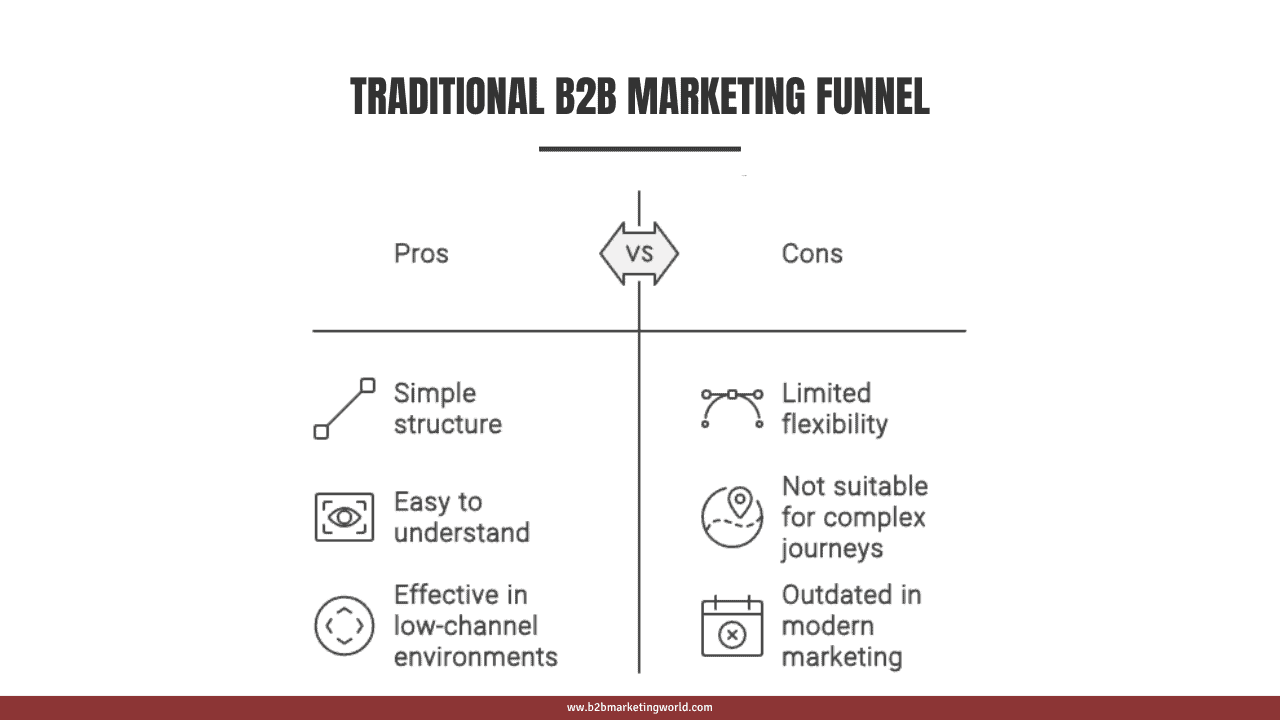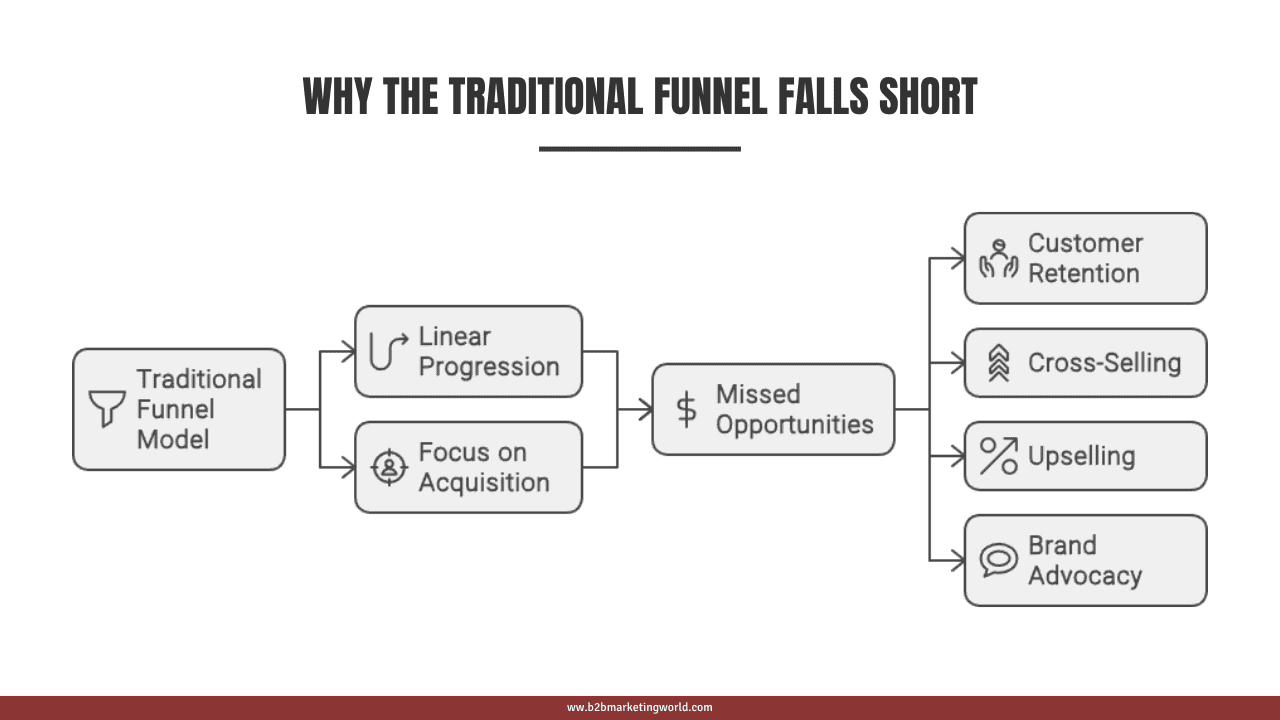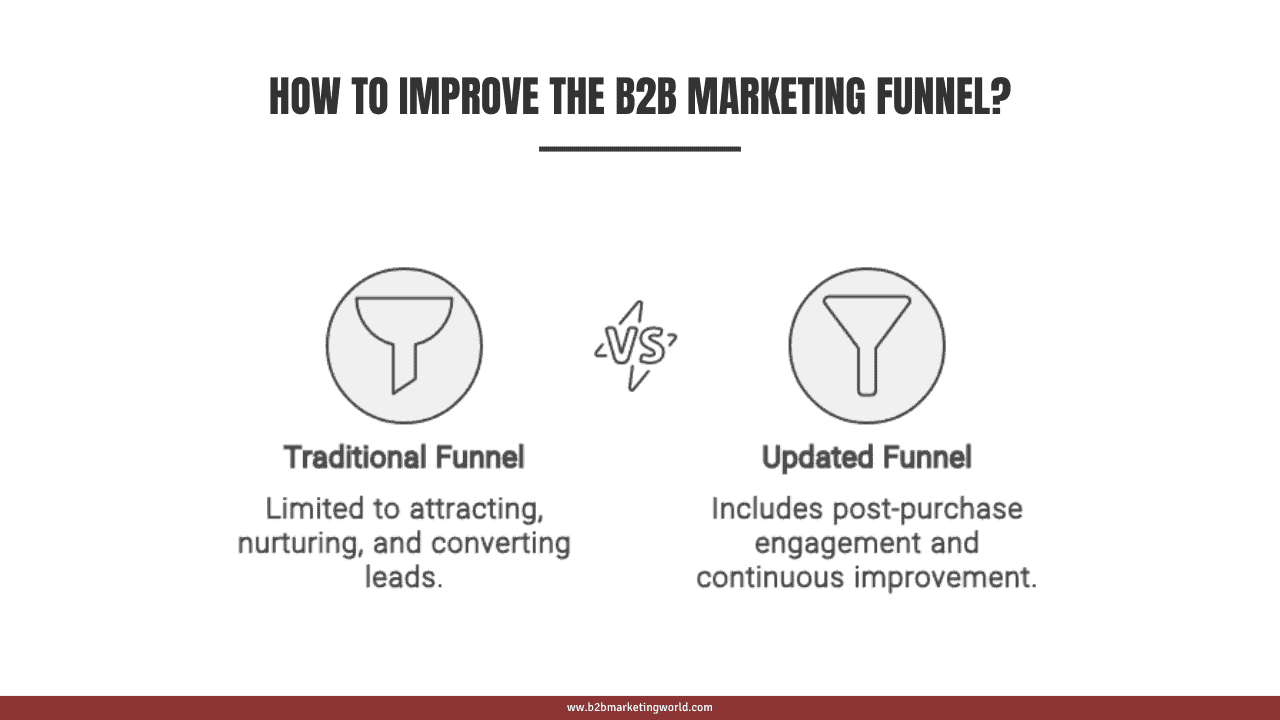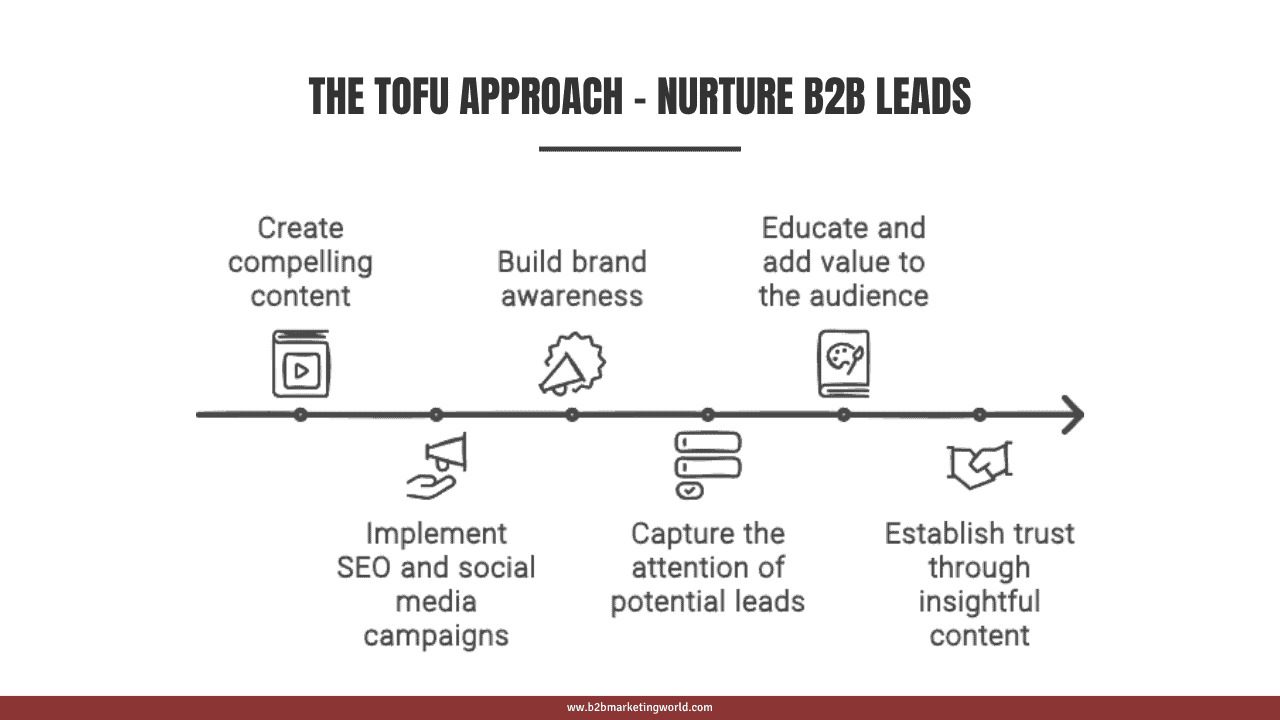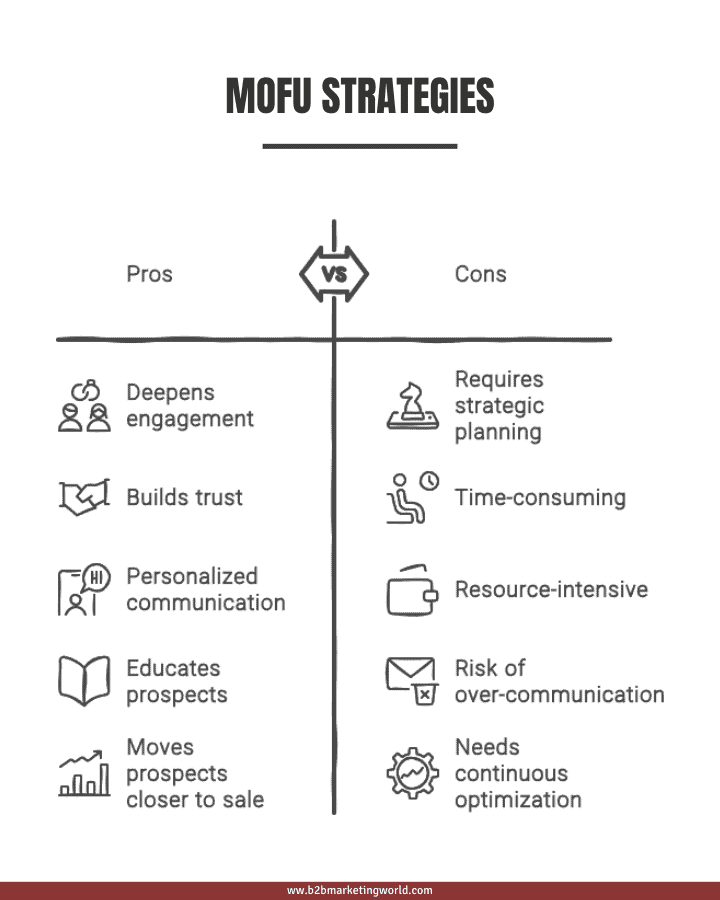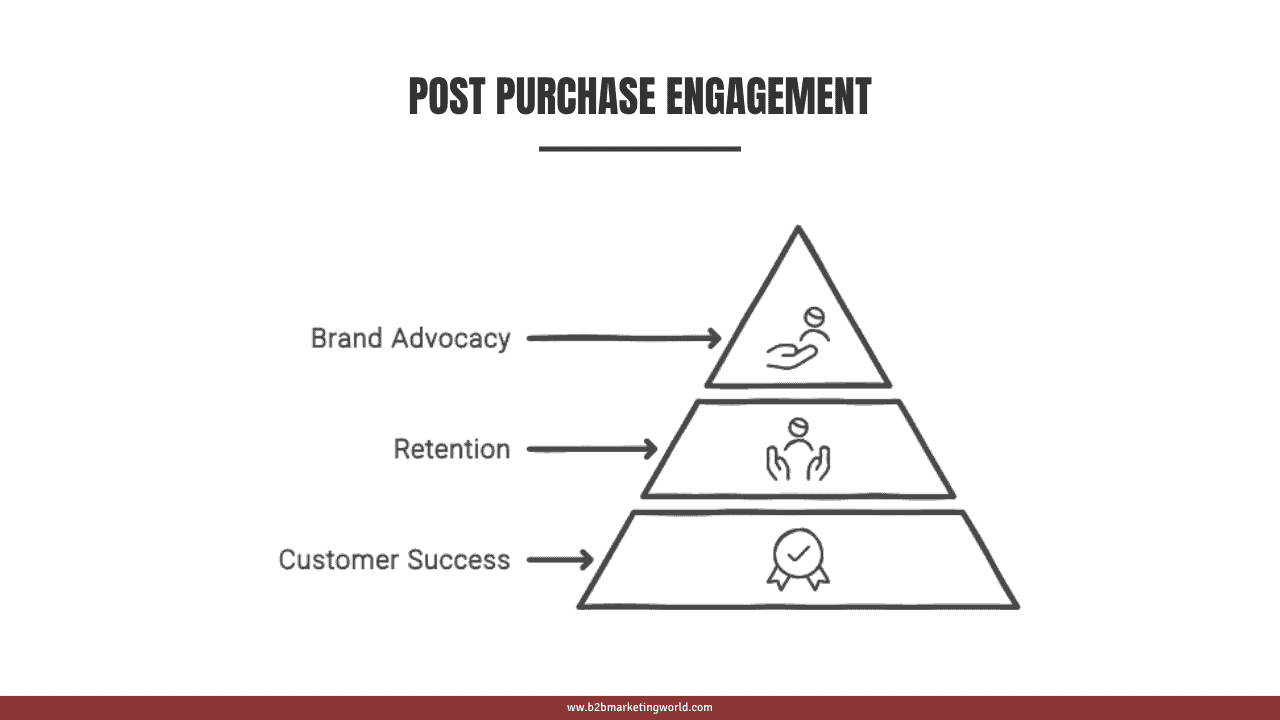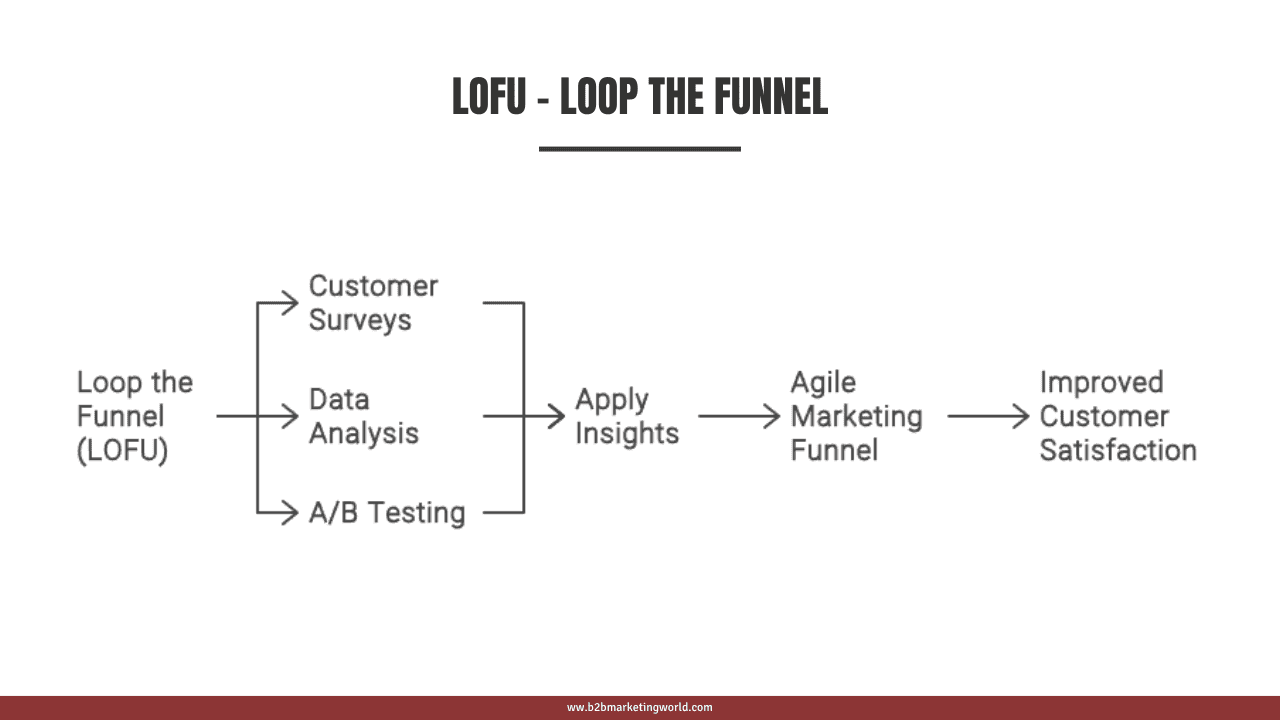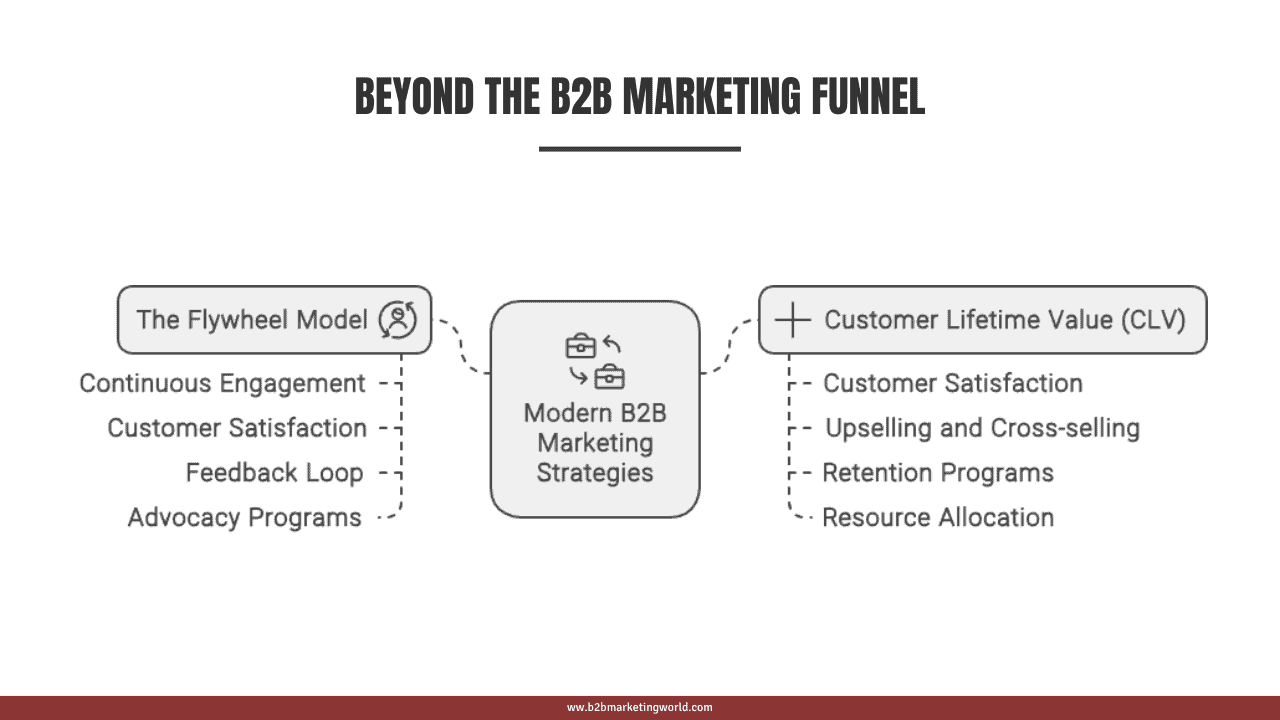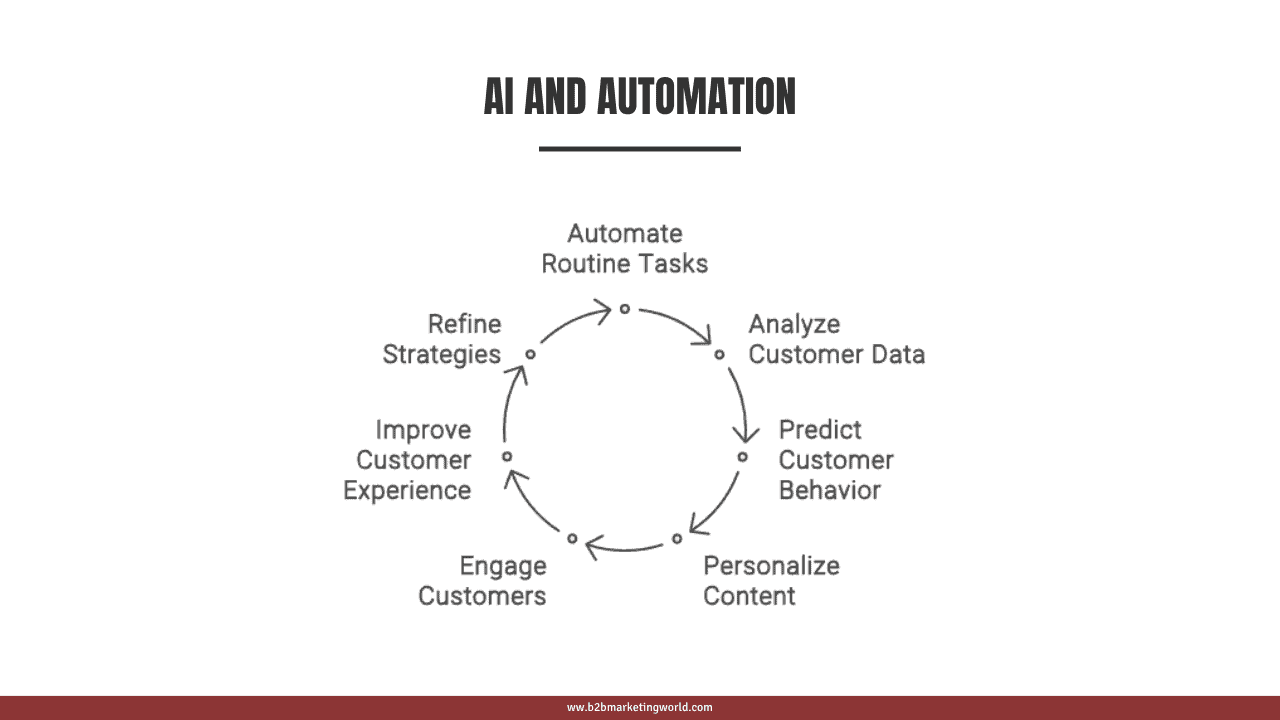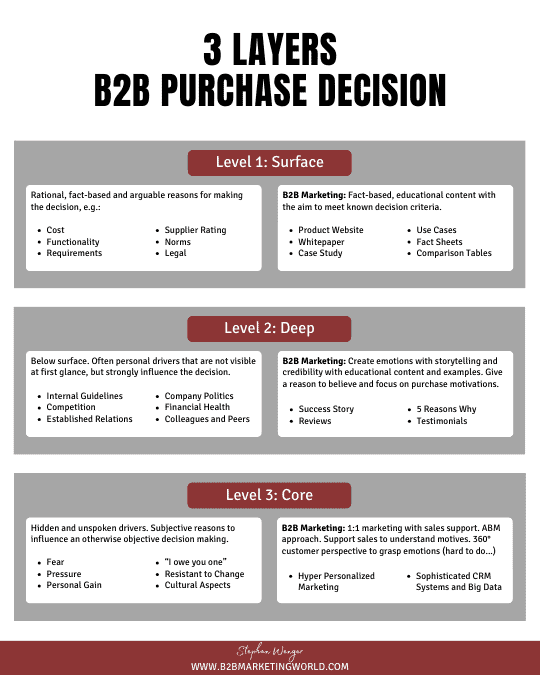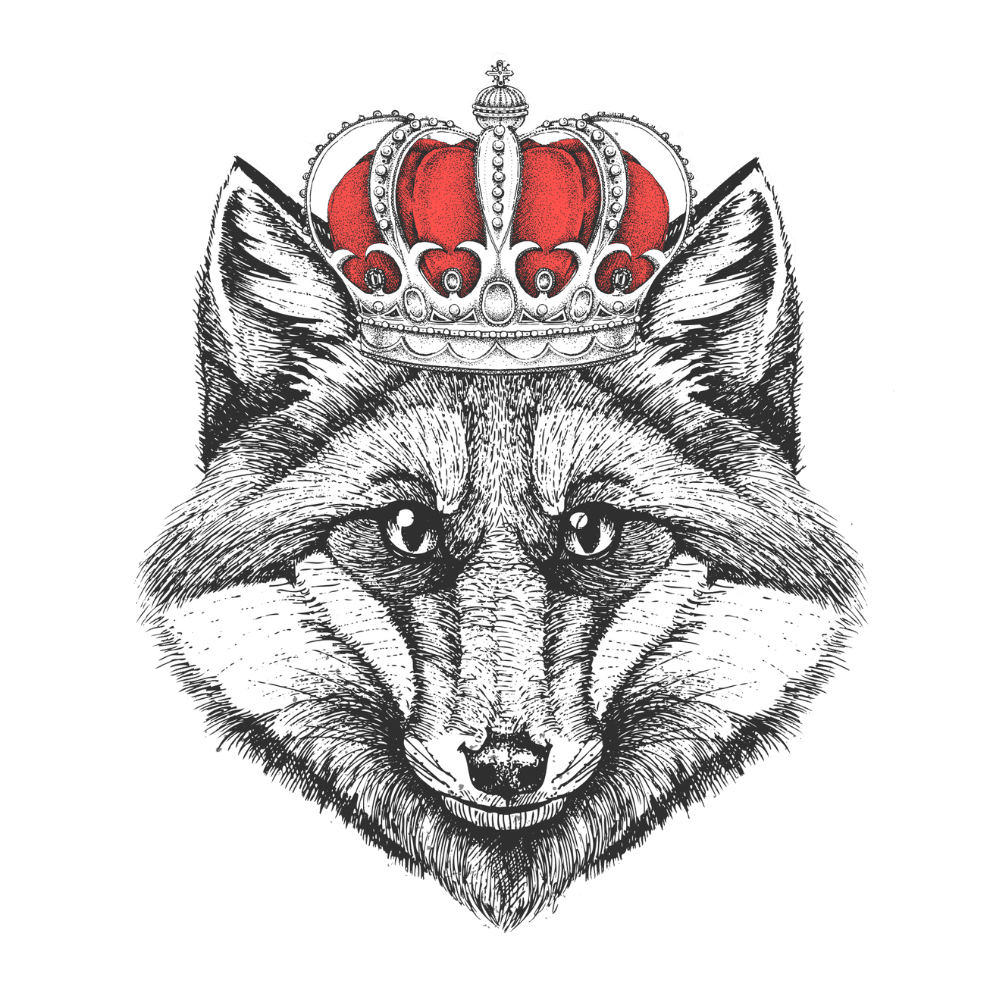B2B Marketing Funnel – A New Approach
5 Steps and why traditional funnels fall short
No time? Read Summary
Table of Contents
Subscribe to our Newsletter and Learn B2B Marketing.
The traditional B2B marketing funnel model is evolving. What once was a straightforward path from awareness to purchase is now a complex journey requiring more enhanced strategies.
This blog post shows the latest developments of the funnel in B2B marketing:
- The evolution and limitations of the classic funnel.
- 5 new stages with a focus on customer engagement.
- Modern approaches like the flywheel model and CLV.
- How AI and automation impact the funnel.
Let’s go.

What is a B2B Marketing Funnel?
Definition. Evolution. And why traditional funnels fall short.
Understanding the customer journey is important for great B2B marketing. The B2B marketing funnel helps you to see this journey. It is a strategic framework. It guides potential customers from initial interaction to a final purchasing decision.
Unlike B2C marketing funnels, B2B marketing funnels are more complex. B2C funnels typically have shorter sales cycles and fewer decision-makers. B2B funnels have extended decision-making processes, multiple stakeholders, and higher-value transactions.
Definition of the B2B Marketing Funnel
The B2B Marketing Funnel outlines the customer journey from a prospect to a customer and traditionally has 3 steps.
It helps companies nurture leads, cultivate strong relationships, and convert prospects into loyal customers.
For instance, in the SaaS industry, a structured funnel effectively:
- navigates potential clients through product demonstrations,
- trials, and consultations,
- steering them toward a purchasing decision.
Understanding this funnel is important for optimizing your marketing strategy and creating business growth.
The Evolution of the B2B Marketing Funnel
The B2B marketing funnel has transformed. It used to be simple. A straight path from awareness to purchase.
- Top of Funnel, TOFU: First, prospects became aware of a product
- Middle of Funnel, MOFU: Then, they explored their options.
- Bottom of Funnel, BOFU: Finally, they made their buying decision.
Traditional B2B Marketing Funnel © B2B Marketing World
This three-step model worked well when there were few channels and buyer journeys were straightforward.
But things have changed. Technology advanced, and with it, buyer behavior.
Classic Funnel no longer fits
The old funnel no longer fits. The digital transformation created new touchpoints and made the journey complex and with many facets.
Content marketing changed the game and shifted the focus from products to customers and solutions. Now, prospects engage across various platforms.
The classic three-phase funnel? It’s no longer enough.
CRM systems, automation tools, and data analytics have revolutionized the funnel. Marketers now have more access to data. They can precisely track customer behavior, allowing for personalized and effective strategies.
The funnel has evolved. It is dynamic and adaptable.
This is why traditional funnel concepts fall short. Let’s have a closer look.
Why Traditional Funnels Fall Short
Relying solely on the traditional funnel is risky. As mentioned – the classic model imagines a linear journey, a simple path from awareness to purchase.
But today’s buyers don’t walk in straight lines. They loop back. They pause. They reconsider.
Decision-makers move between stages, influenced by fresh information, internal debates, and competing priorities.
The traditional funnel doesn’t capture this non-linear behavior. Which can result in missed opportunities and lost leads.
Another limitation of the traditional funnel is its focus on acquisition over retention.
The funnel’s job is considered done as soon as a prospect converts to a customer. But this is shortsighted. Customer retention and advocacy matter just as much as winning new clients.
The traditional funnel lacks a feedback loop, which means businesses miss out on chances to:
- cross-sell
- upsell
- transform happy customers into brand advocates
Why the Traditional Funnel Falls Short © B2B Marketing World
These shortcomings show the urgent need for a more dynamic and customer-focused strategy. The next section introduces an improved funnel model. A model designed to close gaps and provide a more effective approach.
5 Stages of the B2B Marketing Funnel
2 New Stages for the Marketing Funnel
B2B marketing is not static. It changes, and so must we as B2B marketing managers. We must meet them where they are to truly connect with potential customers. As said, while still valuable, the traditional funnel falls short of capturing the full complexity of the B2B buying landscape.
To tackle these challenges, we present an updated B2B marketing funnel. We introduce five key stages:
- Top of the Funnel (TOFU)
- Middle of the Funnel (MOFU)
- Bottom of the Funnel (BOFU)
- After the Funnel (AFU)
- Loop the Funnel (LOFU)
TOFU, MOFU, and BOFU remain essential. They are the pillars of attracting, nurturing, and converting leads.
But with After the Funnel (AFU) and Loop the Funnel (LOFU), we go further:
New Steps: After the Funnel & Loop the Funnel
- AFU focuses on post-purchase engagement, turning customers into brand advocates.
- LOFU closes the loop. Use customer insights and data to enhance the funnel continuously.
Together, these stages create a more dynamic, customer-focused approach. This strategy not only captures opportunities but also builds lasting relationships.
It ensures that our connection with customers extends beyond the sale.
How To Improve the B2B Marketing Funnel © B2B Marketing World
Now, let us discuss each of the 5 steps.
Top of the Funnel (TOFU)
The journey of B2B marketing begins at the Top of the Funnel, also called TOFU. The primary goal is clear: build brand awareness. And capture the attention of potential leads. This stage makes sure your target audience knows who you are. And why they should care.
Think of the classic AIDA model:
- Attention
- Interest
- Desire
- Action
TOFU focuses on the first two. Grab attention and spark that initial interest to guide prospects further down the funnel.
B2B marketers use content marketing, SEO, and social media campaigns to achieve this. The aim? To craft content that educates. Content that adds value and that resonates with the audience. Blog posts, whitepapers, webinars, and industry reports are examples. Each piece must position your brand as a thought leader.
Trust is the currency here. Build it by offering insights that addresses challenges and needs of your audience. Your content must address the pain points of your ideal customer personas.
For example, a B2B tech company might publish a whitepaper on emerging industry trends. This comprehensive report doesn’t just generate leads. It establishes the company as a go-to resource in its field.
The TOFU Approach – Nurture B2b Leads © B2B Marketing World
Middle of the Funnel (MOFU)
The Middle of the Funnel (MOFU) is to turn interest into desire. At this stage, the focus shifts. It is no longer about brand awareness. It is to deepen engagement.
According to the AIDA model, this is the point where you nurture that initial spark of interest. And start to create a real desire for your product or service.
Lead nurturing is crucial here. You must be strategic. Think targeted email campaigns, in-depth webinars, and detailed guides. These tools educate prospects, showing them how your solution directly addresses their challenges. With each touchpoint, you move them closer to a sale. The goal? Move them closer to making a decision by providing insights and building trust.
Personalized communication is the key in the MOFU stage. It’s about building relationships, not just pushing content.
Stephan Wenger
An example: A B2B company hosting a webinar. They do not just talk about industry problems. They offer actionable solutions. Ideally tailored to the audience’s needs. This approach boosts engagement. It strengthens the connection between the prospect and the brand. Pulling them further down the funnel, closer to a purchase.
MOFU Strategies © B2B Marketing World
Bottom of Funnel (BOFU)
The Bottom of the Funnel (BOFU) is where all your hard work pays off. At this stage, leads are about to make a purchase. Your goal is simple yet challenging: turn these prospects into customers.
In the AIDA model, BOFU reflects “Action”. It is a critical phase where interest shifts to commitment.
At this crucial point, your approach must be sharp. Address any final objections with tailored solutions. Personalized proposals, product demos, free trials. Each tool should highlight clear value and make your product stand out.
But there is more. Create a sense of urgency. Deploy strong call-to-action (CTAs) to drive immediate action. Offer a limited-time discount or present a detailed ROI analysis that showcases the financial benefits. These strategies not only resolve doubts but also push prospects to act.
After the Funnel (AFU)
The After the Funnel (AFU) stage is crucial, but marketers often overlook it. The phase begins after the sale and goes beyond the traditional funnel. As discussed, the traditional funnel ends at the conversion. This fourth stage shows the importance of post-purchase engagement. In B2B it is essential to:
- ensuring customer success
- driving retention
- turning customers into advocates
- It ensures lasting business growth.
The focus shifts entirely to nurturing the relationship with your new customer. Effective onboarding is key.
A dedicated customer success team plays an important role. Proactive support guarantees your customers maximum value from your product or service.
By maintaining consistent, ongoing communication, you can address any issues. This keeps customers satisfied and engaged.
But customer satisfaction does not end with retention. It’s the gateway to transforming customers into brand advocates.
Satisfied customers are more likely to refer others. They are valuable testimonials that can boost your marketing efforts.
Consider this: to acquire a new customer is five times more expensive than retaining an existing one. This makes customer retention not just a strategy but a necessity.
Post Purchase Engagement © B2B Marketing World
Loop the Funnel (LOFU)
Loop the Funnel (LOFU), the final stage in the B2B marketing funnel, offers a fresh approach. It’s not just another step; it’s a continuous feedback loop that keeps your marketing effective. Insights from current customers sharpen your strategies and make your funnel increasingly efficient.
LOFU focuses on growth and adaptation. It ensures your marketing grows with the changing needs of your customers. Here are 3 points to implement LOFU effectively:
- Customer Surveys: Regularly gather feedback to understand experiences and challenges.
- Data Analysis: Dig into customer data to identify patterns and find opportunities for improvement.
- A/B Testing: Experiment with different content and strategies to discover what resonates best with your audience.
These strategies give you insights that can be applied throughout your funnel.
For instance, if customers find a part of your product confusing, you can adjust your middle-of-funnel (MOFU) content to clarify those issues. Real-life data creates trust and shows existing customers that you actually care.
The benefit of LOFU is a more agile and responsive marketing funnel. Consistently refining your approach based on real-world feedback creates an agile marketing funnel.
This boosts customer satisfaction and leads to better results across the entire funnel.
LOFU – Loop the Funnel © B2B Marketing World
Let us summarize the 5 new stages of the B2B marketing funnel:
- TOFU (Top of the Funnel): Build awareness and attract potential leads.
- MOFU (Middle of the Funnel): Engage and nurture leads.
- BOFU (Bottom of the Funnel): Convert leads into customers by addressing final objections.
- AFU (After the Funnel): Ensure customer success and turn customers into advocates.
- LOFU (Loop the Funnel): Continuously improve the funnel with customer feedback.
Beyond the B2B Marketing Funnel
Learn about The Flywheel and Customer Lifetime Value
B2B marketing is evolving. New approaches are emerging, challenging the old funnel model.
This chapter introduces a fresh perspective and highlights two strategies transforming customer connections:
- The shift from the funnel to the flywheel
- The focus on Customer Lifetime Value (CLV).
This is another perspective on the discussed 5 Funnel Stages.
These strategies aren’t just alternatives. They offer a path to building relationships.
Unlike the funnel, the flywheel model keeps momentum alive. It turns satisfied customers into loyal advocates. By prioritizing CLV, businesses deepen these relationships, driving consistent growth.
In the next sections, we show how these strategies work together. They create a dynamic, customer-focused marketing approach, ensuring long-term success.
Beyond the B2B Marketing Funnel © B2B Marketing World
The Shift from Funnel to Flywheel
For many companies, the traditional funnel model does not work. Marketers start using the more dynamic flywheel approach. Unlike the funnel, which is a linear journey from awareness to conversion, the flywheel concept is continuous momentum. It keeps customers engaged, creating a cycle that never stops.
What is the Flywheel Model?
The flywheel model sees the customer journey as a cycle, not a straight line. Every interaction adds momentum to the wheel. Delivering value. Providing exceptional service. Gathering feedback. These actions keep the wheel turning.
The model mirrors the ongoing nature of customer relationships. It shifts the focus from acquiring new leads to nurturing existing ones. It encourages repeat business.
Why is the Shift Necessary?
Continuous engagement is essential. The B2B landscape demands more than just a one-time sale. B2B needs long-term relations. The flywheel supports this need by emphasizing ongoing interaction with customers.
Relationships are changing. Modern customers want personalized experiences and long-term support. A linear funnel can’t deliver this. But the flywheel can.
Sustainable growth is the goal. The flywheel achieves this by leveraging customer satisfaction. Satisfied customers become advocates. They refer others. This positive word-of-mouth brings in new leads and helps growth.
How to Implement the Flywheel Model
Focus on customer experience and deliver value at every stage of the journey. Encourage advocacy. Develop programs that turn satisfied customers into brand promoters. Gather feedback. Use insights from customer interactions to adapt your strategies continuously.
Emphasizing Customer Lifetime Value (CLV)
Understanding Customer Lifetime Value (CLV) is crucial for B2B marketers because it is more than just a metric. It is the key to long-term success.
Definition
CLV represents the total revenue a business can expect from a customer throughout their relationship.
Focusing on CLV will change your marketing approach from seeking short-term profits to cultivating sustainable growth.
So, what is CLV, and why is it so vital?
CLV shows how profitable customer relationships are. In the B2B world, where sales cycles are long, and relationships are complex, CLV is a great way to measure ROI. By understanding a customer’s lifetime value, you can make informed decisions about where to allocate resources. Whether in acquiring, retaining, or expanding customer relationships.
To maximize CLV, you must employ several strategies.
- First, ensure customer satisfaction. But don’t just satisfy—aim to delight. When customers are happy, loyalty grows, and repeat business follows.
- Upselling and cross-selling. By offering related products or premium services, you add value for your customers and increase revenue.
- Retention programs are another strategy. Design programs that keep your most valuable customers engaged. This reduces churn and establishes long-term relationships.
The strategic impact of CLV can be pretty big. It helps with your resource allocation. Focus marketing budgets on strategies that enhance customer retention and long-term value.
Rather than acquiring new customers again and again. It also bases customer segmentation, allowing you to target high-value groups with precision.
The Role of AI and Automation in the Funnel
Read how new Technology change the B2B Marketing Funnel
AI and automation are definitely transforming B2B marketing. They allow marketers to process big data and predict customer behavior faster than ever. And automate routine tasks.
But these technologies do more than save time. They offer deep insights into customer needs. That leads to more effective marketing strategies.
- Marketing automation platforms like HubSpot, Adobe Marketo, and alike handle als sort of tasks. For example, email campaigns and social media posts. These platforms ensure consistent communication throughout the funnel.
- Predictive analytics. These AI tools forecast customer behavior, refine lead scoring, and customize content. This helps to enhance your efforts in the middle-of-the-funnel (MOFU).
- Chatbots and AI assistants. They offer quick, responsive support, especially at the top of the funnel (TOFU). Fast responses can capture and nurture leads.
The benefits are significant.
- Increased efficiency. Automating routine tasks gives marketing teams the time to focus on strategic initiatives.
- Enhanced targeting. AI analyzes customer data and delivers personalized content and offers that boost conversion chances.
- Improved customer experience. Automation creates a seamless, engaging experience across all touchpoints.
Incorporating AI and automation into the B2B marketing funnel is no longer optional. It’s crucial for staying competitive and meeting the demands of a changing market.
AI and Automation © B2B Marketing World
3 Layers of a B2B Purchase Decision
Drivers Behind a B2B Purchase
The following image shows the 3 layers of a B2B purchase decision. These aspects need to be considered in your B2B content marketing efforts, as motivations and drivers have different causes.
3 Layers of a B2B Purchase Decision © B2B Marketing World
How to Measure Success
KPIs
There are two approaches to do so:
- Measure absolute numbers
Each step and hence, each status can be measured in absolute numbers. E.g. how many leads were generated by marketing? How many MQLs were accepted by sales, etc. This perspective helps to measure the effectiveness.
- Measure rations of absolute numbers
The absolute numbers of each step can be compared to the absolute numbers of another step. These ratios describe the effectiveness. The closer the rations to 1, the higher the effectiveness. If you can convert 100 opportunities into 100 closed deals, your effectiveness is 100%.
Ratios also help to estimate how much input you need to meet a certain output aim. If your goal is to close 100 deals and your ratio to opportunities is 25%, you need 400 opportunities to meet your goal. This works back to e.g. how many contacts are necessary to meet your final aim.
Frequently Asked Questions
Find Answers to the Most Important Questions
The B2B Marketing Funnel outlines the customer journey from a prospect to a customer and traditionally has 3 steps. Modern funnels include 2 more steps to address the post-purchase phase and create flexibility.
A modern B2B marketing funnel has 5 steps. A full funnel marketing strategy covers all steps and addresses the complete user journey. This includes a deep understanding of your customers buying journey.
A modern B2B marketing funnel has 5 stages: Top of the Funnel (TOFU), Middle of the Funnel (MOFU), Bottom of the Funnel (BOFU), After the Funnel (AFU) and Loop the Funnel (LOFU). These modern 5 steps reflect the buyers journey from creating awareness (TOFU), lead nurturing (MOFU) till purchase (BOFU) and beyond (AFU, LOFU).
Summary [TL;DR]
Summary of the B2B Marketing Funnel
The B2B marketing funnel has changed significantly.
Once a linear path from awareness to purchase, it is now a dynamic, customer-centered strategy. That better reflects the complexities of modern buyer behavior.
The Evolution of the B2B Marketing Funnel:
- Traditional funnels, which direct customers from awareness to purchase, are increasingly obsolete.
- They fail to address the complexities of today’s buyers and overlook post-purchase engagement. Which is a critical aspect of modern marketing. The funnel has evolved into something much more complex.
The Five New Stages of the B2B Marketing Funnel:
- The Top of the Funnel (TOFU) focuses on building brand awareness and creating interest.
- As leads progress, Middle of the Funnel (MOFU) engages and nurtures them. Guiding them steadily toward a purchase decision.
- At the final stage, Bottom of Funnel (BOFU) converts leads into customers. At this stage, companies address last-minute concerns and showcase value.
Two new steps that go beyond the traditional funnel concept
After the Funnel (AFU) ensures customer success, enhances retention, and turns satisfied customers into advocates.
Loop the Funnel (LOFU) uses customer feedback and insights to refine marketing strategies continually. This creates a loop that gives feedback into the funnel.
But there is even more beyond the B2B Marketing Funnel:
- The flywheel starts to replace the traditional funnel. This new model highlights the importance of continuous customer engagement. And loyalty. It prioritizes a seamless and positive experience throughout the whole customer journey.
- Customer Lifetime Value (CLV) is central to this approach. CLV shows the importance of nurturing long-term relationships for sustainable growth.
This article also discussed the Role of AI and Automation:
- Artificial intelligence and automation are important in optimizing the modern marketing funnel. These technologies boost efficiency, improve targeting, and enhance the overall customer experience.
- Predictive analytics and chatbots transform how businesses approach and adapt their marketing strategies.
Stephan Wenger
B2B Marketing Expert, Editor and Marketing Management Consultant
Stephan Wenger is a seasoned B2B Marketing Expert with more than 10 years of experience in leading global companies. His extensive expertise lies in the realms of B2B online marketing, content marketing, strategic marketing, and driving synergy between sales and marketing, including effective lead management.
You May Like the Following Articles
B2B Sales
Business-to-business sales (B2B Sales) refers to companies and sales teams selling to other companies. Companies must establish touchpoints throughout the buying process to ensure consistent engagement with potential buyers at every stage. This requires both the marketing team and sales reps to work together. In this blog post, we will show what B2B sales is, what it means, and how it works and give you real-life sales examples.

